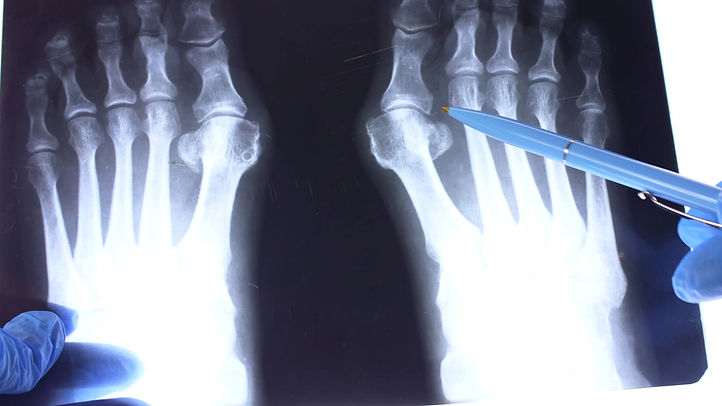

Hallux Valgus
It is the situation where the first toe of the foot is angled towards the outside of the foot and a bony protrusion occurs in the inner part of the first toe joint of the foot. It is the most common deformity in the foot. It is seen on average 10 times more often in women than in men. Although the real reason is unknown; The conditions that are thought to cause hallux valgus formation can be listed as follows:
-
Familial (genetic) predisposition.
-
Very flexible ligaments between the joints of the feet and looseness in the joints due to this.
-
Cerebral palsy
-
flat feet
-
achilles tendon tension
-
The use of high heels and especially narrow front shoes.

Diagnosis is made by clinical examination and radiological evaluation. Examination findings are pathological angulation of the 1st toe outward and a hard protrusion on the inside of the 1st toe joint. This protrusion is red in color and painful, especially due to bursitis and inflammation caused by shoe pressure. In advanced cases, it is seen that the 1st finger goes under the 2nd finger and hammer toe deformity and calluses develop in the other fingers, especially in the 2nd finger. In the radiological examination, the relationship of the toe and finger bones with each other is examined. Normally, the angle between the 1st metacarpal bone and the 1st phalanges should be less than 15 degrees, and the angle between the 1st and 2nd comb bones should be less than 9 degrees; In hallux valgus, it is seen that these values are exceeded.
Treatment is evaluated according to the degree of the disorder. In mild deformities, shoes with shorter heels and wider front are recommended to the patient. In cases where bone protrusion occurs, it is recommended to use pads that cover this part and prevent it from rubbing against the shoe. Night splints that keep the finger in its normal position and hallux valgus rollers placed between the 1st and 2nd fingers may help. In case of pain and inflammation due to excessive shoe compression, cold application and various painkillers are recommended. However, surgical methods may also be preferred due to the progression of the deformity, providing permanent treatment, preventing the daily life of the person and aesthetic concerns.

In surgical treatment, many surgical techniques have been described to correct hallux valgus deformities. Considering the age of the patient, the possible cause of the deformity, and the degree of deformity, the surgical technique to be applied is decided. No plaster cast is required after surgery, and the patient can walk with foot in one day; however, care should be taken not to use the forefoot during walking. Hallux valgus boots can be used to facilitate walking. Full recovery time is usually 4-6 weeks. Normal gait is allowed when union is observed in the corrected bone area. Complications; infection, nonunion of the bone incision area, recurrence, prolonged swelling in the operation area. However, the incidence of complications is very low.

